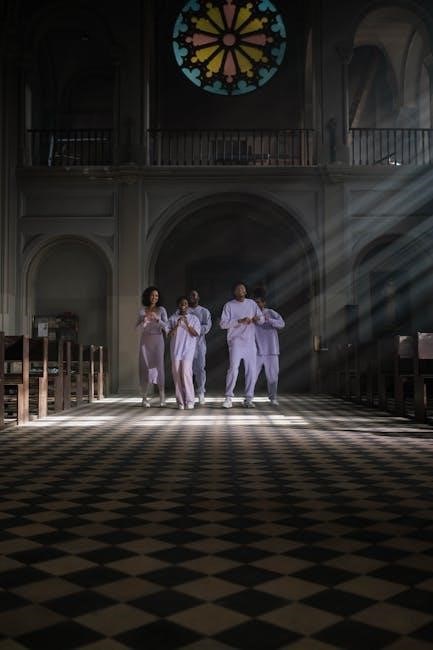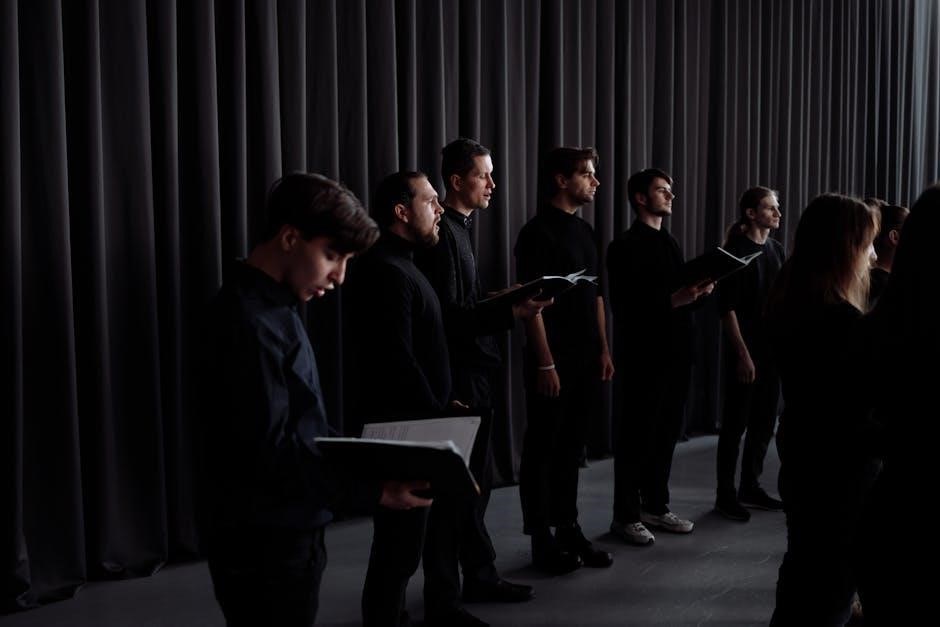Hallelujah Chorus SATB PDF: An Overview
The “Hallelujah” Chorus from Handel’s Messiah is a cornerstone of choral music. A SATB (Soprano, Alto, Tenor, Bass) PDF allows choirs to access and perform this powerful piece. These PDFs can be found for free or purchased online and are used in performances.
The “Hallelujah” Chorus is arguably the most recognized movement from George Frideric Handel’s Messiah, an English oratorio first performed in Dublin in 1742. This triumphant chorus is celebrated for its powerful declaration of the reign of God. The text is derived from the Book of Revelation.
The chorus’s enduring appeal lies in its dramatic structure, melodic lines, and harmonic richness. It is frequently performed during Christmas and Easter seasons. Its universal message of hope and redemption transcends religious boundaries. Handel’s masterful composition captures the essence of jubilation.
The “Hallelujah” Chorus stands as a testament to Handel’s genius and continues to inspire audiences worldwide. Its inclusion in countless performances and recordings solidifies its status as a timeless masterpiece. The chorus embodies the spirit of Baroque music and remains a powerful symbol of faith.
The arrangement for SATB (Soprano, Alto, Tenor, Bass) choir makes it accessible to a wide range of vocal ensembles, contributing to its widespread popularity and enduring legacy. The chorus resonates with singers and listeners alike, making it a cherished piece of musical history.
The Significance of SATB Arrangement
The SATB arrangement of the “Hallelujah” Chorus holds immense significance in making this iconic piece accessible to a wider range of choirs. SATB, which stands for Soprano, Alto, Tenor, and Bass, is the standard vocal arrangement for most choirs, from amateur groups to professional ensembles. This arrangement allows for a balanced and full sound, with each voice part contributing to the overall harmony and texture of the music.
By arranging the “Hallelujah” Chorus for SATB, it becomes readily performable by choirs of varying sizes and skill levels. The arrangement allows for clear vocal lines. It also provides a foundation for musical interpretation. The SATB arrangement allows choirs to engage with a masterpiece of Western music.
The availability of SATB sheet music, particularly in PDF format, further enhances accessibility. Choirs can easily obtain and distribute the music. This ensures consistent performance across different venues. The SATB arrangement ensures that the “Hallelujah” Chorus remains a staple of choral repertoire. It allows future generations to experience the power and beauty of Handel’s masterpiece.

Availability of Hallelujah Chorus SATB PDF Sheet Music
Finding the “Hallelujah” Chorus SATB PDF sheet music is generally easy. Numerous online resources offer both free downloads and paid options. This accessibility allows choirs of all budgets to perform the renowned piece.
Free Download Sources
Several websites provide free downloads of the “Hallelujah” Chorus SATB PDF sheet music. These sources often include public domain versions or arrangements shared by musicians and educators. Websites dedicated to choral music resources frequently host such free PDFs, offering an accessible option for choirs with limited budgets.
Repositories of classical music scores are another excellent place to find free downloads. These sites typically archive older editions of the “Hallelujah” Chorus, which are no longer under copyright. However, users should carefully review the specific arrangement to ensure it meets their needs and skill level.
It’s important to verify the quality and accuracy of free downloads. Some free versions might contain errors or be poorly formatted. Always compare multiple sources and, if possible, consult with a music director or experienced musician to ensure the downloaded PDF is suitable for performance. Consider also that some “free” websites might have some kind of malicious software attached to the file.
Paid Sheet Music Options
For a higher-quality and more reliable version of the “Hallelujah” Chorus SATB PDF, numerous reputable sheet music retailers offer paid options. These retailers provide professionally typeset editions, ensuring accuracy and readability. Purchasing sheet music often grants certain performance rights or licenses, which may be required for public performances or recordings.
Major sheet music publishers offer various arrangements of the “Hallelujah” Chorus, catering to different skill levels and choir sizes. These arrangements may include piano or organ accompaniments, as well as orchestral scores. Purchasing from a reputable publisher guarantees a legally obtained copy and supports the composers and arrangers involved.
Online sheet music stores are a convenient way to browse and purchase “Hallelujah” Chorus SATB PDFs. These stores often provide previews of the sheet music, allowing choirs to assess the difficulty and arrangement before buying. Many stores also offer digital downloads, enabling immediate access to the music. Moreover, some offer transpositions of the song in different keys to better accommodate your ensemble.
Analyzing the Hallelujah Chorus SATB Arrangement
Analyzing the “Hallelujah” Chorus SATB arrangement involves understanding its musical structure, key, and vocal ranges. The arrangement’s difficulty and the demands it places on each voice part are also essential considerations for performance.
Musical Structure and Key
The “Hallelujah” Chorus, a segment of Handel’s Messiah, is celebrated for its distinct musical structure. The piece is primarily in the key of D major, a key chosen for its bright and triumphant character that complements the text’s celebratory nature. The structure alternates between homophonic sections, where all voices sing in rhythmic unison, and polyphonic sections, where independent melodic lines interweave.
The chorus opens with a declarative statement in unison, immediately establishing the powerful and celebratory tone. This gives way to more intricate passages where each voice part contributes to a rich, layered texture. Handel masterfully employs techniques like imitation, where melodic phrases are echoed between different voice parts, creating a sense of call and response. The use of recurring motifs and thematic development throughout the chorus provides a sense of unity and progression.
The shifts between different textures and vocal groupings are crucial to the chorus’s impact. The famous “King of Kings” section is a prime example, where the voices build in intensity, culminating in a resounding affirmation. Understanding the interplay between these structural elements is vital for any choir performing this iconic work.
Vocal Ranges and Difficulty
The “Hallelujah” Chorus in SATB arrangement presents a moderate level of difficulty for most choirs, demanding solid vocal technique and stamina. The soprano part often reaches relatively high notes, requiring a secure upper register. Altos need a strong middle voice to maintain clarity within the texture. Tenors must navigate some challenging passages, including sustained notes in their higher range, while basses provide the harmonic foundation with consistent tone.
The vocal ranges are generally manageable for experienced singers. However, the extended duration of the chorus and the need to maintain energy throughout pose a challenge. Choirs should focus on breath control, diction, and clear enunciation to ensure a polished performance. The interplay between the vocal parts also demands careful attention to balance and blend.
While not excessively difficult, the “Hallelujah” Chorus requires dedicated rehearsal and attention to detail. Choirs must be prepared to work on intonation, rhythm, and dynamics to fully capture the power and majesty of Handel’s masterpiece. Careful attention should be paid to each vocal line.

Performance Considerations for SATB Choirs
Performing the “Hallelujah” Chorus requires careful attention to vocal technique, balance, and dynamics. Choirs should focus on clear diction, breath control, and maintaining energy throughout the piece for a powerful and moving rendition.
Tips for Mastering the Chorus
Mastering the “Hallelujah” Chorus involves meticulous practice and attention to detail. Start with sectional rehearsals, focusing on individual voice parts to ensure accuracy in notes and rhythms. Pay special attention to entrances and cutoffs, striving for precise ensemble execution. Consistent tempo is crucial.
Address challenging passages with targeted drills, breaking them down into smaller, manageable segments. Work on breath control and phrasing, encouraging singers to support their voices throughout long phrases. Dynamics play a key role; practice the contrasting sections to create dramatic impact.
Ensure proper vowel formation and diction for clarity. Listen attentively to recordings of professional performances to gain insights into interpretation and style. Emphasize the importance of singing with conviction and emotion, conveying the powerful message of the text.
Consider hiring a vocal coach or conductor with experience in choral music to provide guidance and feedback. Regular rehearsals and consistent practice are essential for achieving a polished and inspiring performance. Focus on intonation for a harmonious sound.
Accompaniment Options (Orchestra, Piano, Organ)
The “Hallelujah” Chorus offers diverse accompaniment options, each adding a unique dimension to the performance. The original orchestration provides a rich and full sound, featuring strings, woodwinds, brass, and percussion. This option is ideal for larger ensembles and formal concerts, capturing Handel’s intended grandeur.
A piano accompaniment is a versatile and practical choice, suitable for rehearsals and smaller performances. A skilled pianist can emulate the orchestral textures, providing harmonic support and rhythmic drive. The piano version is readily available in most SATB PDF scores.
An organ accompaniment offers a majestic and resonant sound, particularly well-suited for church settings. The organ’s sustained tones and varied registrations can create a powerful and uplifting atmosphere. The organ part often includes pedal notes that add depth and gravitas.
The choice of accompaniment depends on the ensemble’s resources, the venue, and the desired effect. Experiment with different options to find the best fit for your choir and audience.

Copyright and Public Domain Status
The original Hallelujah Chorus is in the public domain. However, specific arrangements found in SATB PDFs may have copyright restrictions. Always verify usage rights before distributing or performing.
Understanding Usage Rights
When accessing a Hallelujah Chorus SATB PDF, understanding usage rights is crucial to avoid copyright infringement. While Handel’s original composition is in the public domain, individual arrangements or editions often have their own copyrights. These copyrights protect the specific work of the arranger, including any alterations, modifications, or additions made to the original score.
Before performing or distributing an SATB PDF, carefully examine the document for copyright notices or licensing information. Public domain versions allow for free use, including performance and reproduction, without permission. However, copyrighted arrangements may require obtaining permission from the copyright holder, typically the arranger or publisher. This permission may involve paying royalties or securing a license for performance or distribution.
Websites offering free downloads should be scrutinized for their legitimacy and adherence to copyright laws. Ensure that the site has the right to distribute the sheet music legally. If in doubt, consider purchasing a licensed copy from a reputable music publisher to guarantee compliance with copyright regulations and support the arranger’s work. Failure to comply with copyright laws can lead to legal repercussions.
